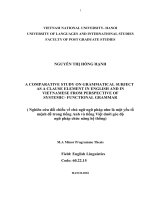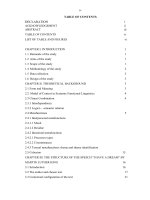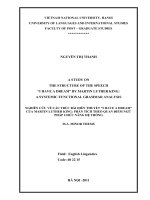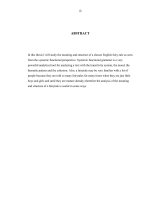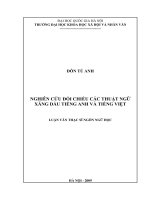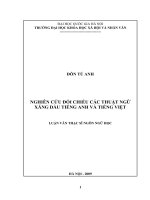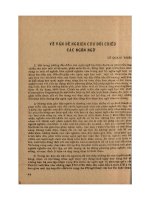nghiên cứu đối chiếu về chủ ngữ ngữ pháp như là một yếu tố mệnh đề trong tiếng anh và tiếng việt dưới góc độ ngữ pháp chức năng hệ thống
Bạn đang xem bản rút gọn của tài liệu. Xem và tải ngay bản đầy đủ của tài liệu tại đây (1.13 MB, 47 trang )
1
VIETNAM NATIONAL UNIVERSITY- HANOI
UNIVERSITY OF LANGUAGES AND INTERNATIONAL STUDIES
FACULTY OF POST GRADUATE STUDIES
NGUYỄN THỊ HỒNG HẠNH
A COMPARATIVE STUDY ON GRAMMATICAL SUBJECT
AS A CLAUSE ELEMENT IN ENGLISH AND IN
VIETNAMESE FROM PERSPECTIVE OF
SYSTEMIC- FUNCTIONAL GRAMMAR
( Nghiên cứu đối chiếu về chủ ngữ ngữ pháp như là một yếu tố
mệnh đề trong tiếng Anh và tiếng Việt dưới góc độ
ngữ pháp chức năng hệ thống)
M.A Minor Programme Thesis
Field: English Linguistics
Code: 60.22.15
HANOI-2010
2
VIETNAM NATIONAL UNIVERSITY- HANOI
UNIVERSITY OF LANGUAGES AND INTERNATIONAL STUDIES
FACULTY OF POST GRADUATE STUDIES
NGUYỄN THỊ HỒNG HẠNH
A COMPARATIVE STUDY ON GRAMMATICAL SUBJECT
AS A CLAUSE ELEMENT IN ENGLISH AND IN
VIETNAMESE FROM PERSPECTIVE OF
SYSTEMIC- FUNCTIONAL GRAMMAR
( Nghiên cứu đối chiếu về chủ ngữ ngữ pháp như là một yếu tố
mệnh đề trong tiếng Anh và tiếng Việt dưới góc độ
ngữ pháp chức năng hệ thống)
M.A Minor Programme Thesis
Field: English Linguistics
Code: 60.22.15
Supervisor: Assoc. Prof. Dr. Ngô Đình Phương
HANOI-2010
5
TABLE OF CONTENTS
ACKNOWLEDGEMENTS………………………………………………………….…i
ABSTRACT…………………………………………………………………………….ii
TABLE OF CONTENTS…………………………………………………………… iii
PART A: INTRODUCTION
1. Rationale…………………………………………………………………………… 1
2. Aims……………………………………………………….………………………….2
3. Scope of the study……………………………………………………………………2
4. Method of the study ……………………………… ………………………………. 2
5. Design of the study………………………………………………………………… 3
Chapter 1: Theoretical Orientations
1.1. Introduction .………………………………………………………………………4
1.2. Theories of systemic- functional grammar as distinguished from other formal
Grammar……………………………………………………………………………….4
1.3. Definition of grammatical subject.……………………………………………….5
1.3.1. From traditional perspective. .…………………………………………………5
1.3.2. From systemic functional grammar……………………………………………6
1.4. Kinds of subject………………………………………………………………… 6
1.4.1. Psychological subject………………………………………………… 7
1.4.2. Grammatical subject. ………………………………………………………… 7
1.4.3. Logical subject………………………………………………………………… 7
1.5. Three lines of meaning in the clause…………………………………………… 8
1.6. Conclusion………………………………………………………………….…… 9
Chapter 2: Grammatical subject in English on the view of systemic functional
grammar
2.1. Introduction.…………………………………………………………………… 10
2.2. Structure of the mood.………………………………………………………… 10
2.2.1. Subject and finite………………………………………………………………10
2.2.2. Meaning of subject and finite…………………………………………………10
2.3. Identifying subjects and finites………………………………………………….11
6
2.3.1. Identifying subjects…………………………………………………………….11
2.3.2. Identifying finites………………………………………………………………12
2.4. Mood in some kinds of English sentences………………………………………13
2.4.1. The declaratives……………………………………………………………… 13
2.4.2. The interrogatives………………………………………………………………14
2.4.2.1. Wh- interrogatives……………………………………………………………14
2.4.2.2. Yes/ No interrogatives……………………………………………………… 15
2.4.3. The imperatives……………………………………………………………… 15
2.4.3.1. Exclusive imperatives……………………………………………………… 16
a. Unmarked imperatives…………………………………………………………….16
b. Marked imperatives……………………………………………………………… 17
2.4.3.2. Inclusive imperatives…………………………………………………………18
2.4.3.2.1. Unmarked imperatives…………………………………………………… 19
a. Unmarked positives……………………………………………………………… 19
b. Unmarked negatives……………………………………………………………… 19
2.4.3.2.2. Marked imperatives……………………………………………………… 19
a. Marked positives…………………………………………………………….…… 19
b. Marked negatives………………………………………………………………… 19
2.4.4. Exclamatives…………………………………………………………………….20
2.5. Summary…………………………………………………………………….… 20
Chapter 3.A contrastive analysis on the grammatical subject in English and
Vietnamese on the view of Systemic- Functional Grammar
3.1. Introduction.…………………………………………………………….……… 21
3.2. Mood structure…………………………………………………………….….… 21
3.3. Identification of subject…………………………………………………….….…23
3.4. Position of subject in some kinds of sentences…………………………….……24
3.4.1. Declaratives……………………………………………………………….…….24
3.4.2. Interrogatives……………………………………………………………… …25
3.4.3. Imperatives………………………………………………………………… ….27
3.4.3.1. Unmarked imperatives…………………………………………………….…27
a. Unmarked positives……………………………………………………………… 28
7
b. Unmarked negatives……………………………………………………………… 28
3.4.3.2. Marked positives………………………………………………………… ….28
3.4.3.3. Marked negatives…………………………………………………………… 28
3.4.4. Exclamative……………………………………………………………….…….28
3.5. Summary ………………………………………………………………… ……31
PART C: CONCLUSION
1. Conclusion…………………………………………………………………….…….32
2. Implications…………………………………………………………………… … 33
REFERENCES……………………………………………………………………… 35
APPENDIX
8
PART A: INTRODUCTION
1. Rationale
The history of linguistics has seen many different grammatical approaches, such as
traditional grammar, structural grammar, and transformational- generative grammar, each
of which defines its own objectives. Of the grammatical approaches, traditional grammar
sees grammar as a set of rules which specify all grammatical structures of the language. In
this approach there is a main focus on making a distinction between grammatical and
ungrammatical sentences. Sentences are considered as the largest units in the grammatical
system of a language and they are used to illustrate different grammatical rules. The
primary concern of this approach is on the forms of grammatical structure rather than their
meanings or uses in contexts. Because of its earlier foundation, traditional grammar has
greatly influenced on linguistics and language teaching
Another approach that also has a great influence on language research and teaching is
functional grammar. The theory of functional grammar was originally introduced by
M.A.K. Halliday in the early 1960s. Systemic functional linguistics sees language as a
system of communication and analyses grammar to discover how it is organized to
exchange meanings. The primary concern is with the function of structures and with their
meanings in context. All languages take place in the context. Rather than studying the
distinction between grammatical and ungrammatical forms, the focus of this approach is on
the appropriateness of a form in a particular context. Functional grammar has been studied
by many grammarians like Halliday(1985, 1994), Bloor (1994), Eggins (1994), Thomson
(1996), Morley(1985), etc. In Vietnamese there are some functional studies that should be
counted are Cao Xuân Hạo (1991 Tiếng Việt: sơ thảo ngữ pháp chức năng; Nguyễn Thị
Quy (2002) Ngữ pháp chức năng tiếng Việt; Hoàng Văn Vân (2002) Ngữ pháp kinh
nghiệm của cú tiếng Việt: Miêu tả theo quan điểm chức năng hệ thống
Personally, the writer finds functional grammar very interesting as it offers a full study
on language and language teaching which focuses on communication. This is a very useful
way to teach and learn English. The intention of this study is to illuminate the
characteristics of grammatical subject in English and to compare it with Vietnamese
language to have a fully understanding of this term. However, due to the limitation of
9
time, the writer is not able to cover all aspects of grammatical subject in the two languages.
What the writer would like to do is to study grammatical subject in English in comparison
with that in Vietnamese. The result of this study contributes to facilitation of the teaching
and learning of English.
2. Aims
Within the framework of a M.A minor thesis, the study is aimed at:
Presenting, describing and analyzing the grammatical subject in English and in
Vietnamese in the light of systemic- functional grammar
Identifying the similarities and differences between grammatical subject in English
and its equivalent in Vietnamese in term of mood structure
Making some suggestions for teaching and learning grammatical subject to teachers
and learners of English
In order to reach the target, the following research questions are posed:
1. What is the grammatical subject?
2. What are the similarities and differences of the grammatical subject in English and its
equivalences in Vietnamese?
The writer also would like to find out the implications of this study in teaching and
learning grammatical subject (including the identification of it) to teachers and learners of
English.
3. Scope of the study
The study does not cover all aspects of functional grammar but limits itself to a minor
aspect of functional grammar. The main focus is on grammatical subject in English and in
Vietnamese viewed from perspective of the systemic- functional grammar.
To explicit the grammatical subject it is essential to study it in mood structure in which
the subject is located. Other aspects such as theme- rheme are not included in this study
The research is confined to the description, analysis and comparison of the
grammatical subject in term of position in kinds of sentences.
4. Method of the study
This study is primarily concerned with comparing grammatical subject between English
and Vietnamese. The research methods used in the study are description, comparison and
analysis. The descriptive and analytic is used in description of grammatical subject in
10
English and Vietnamese. The comparative is used in the comparison of grammatical
subject in the two languages.
A number of examples are taken from many sources in The English and Vietnamese
languages. They are analyzed to identify the similarities and differences between
grammatical subject in English and in Vietnamese.
5. Design of the study
The thesis is divided into three parts:
Part A: The Introduction: presents the rationale of the study, the aims, scopes, methods,
and the design of the study
Part B: Development: consists of four chapters
Chapter 1: provides the theoretical background of the study, functional grammar, the
notion of grammatical subject in two aspects of grammar, kinds of subjects and three lines
of meaning in the clause
Chapter 2: investigates the grammatical subject in English on the view of systemic
functional grammar
Chapter 3: presents the systemic functional comparison between grammatical subject in
English and in Vietnamese
Part C: Conclusion: summarizes the whole study and offers some implications for
language teaching and learning
11
Chapter 1. Theoretical Background
1.1. Introduction
As already mentioned in the previous part, this study‟s aim is to investigate the
grammatical subject in English and Vietnamese from systemic functional perspective. In
this chapter, we shall attempt to explore the notions of grammatical subject, definition of
grammatical subject from different perspectives, kinds of subject and three lines of
meaning in the clause. We focus our study on systemic- functional grammar which has an
influence on grammatical subject in this study.
1.2. Theories of systemic- functional grammar as distinguished from other formal
grammar
Over the history, the study of language has been approached from different points of
view
Traditional grammar views language as a system of interrelated categories. It attempts
to create rules about how people use languages. Its aim is to provide rules for correcting
what are offered to as grammatical errors. This theory are criticized for paying too much
attention to details of language and its description of language seems to be inadequate for
language teaching.
Descriptive grammar arises in the early 1970s with the publication of “A
comprehensive grammar of the English language”, (Quirk and Greenbaum, 1972).
This grammar aims to describe the grammatical system of language, that is, what speakers
of the language “unconsciously” know, which enables them to speak and understand
language. It is believed to provide good ground for deeper studies in other later grammars
such as transformational – generative and systemic- functional grammar.
The Transformational- Generative grammar, developed by Chomsky (1968) makes a
distinction between “surface structure” and “deep structure” of language. It is a “logical
specification of the syntactic knowledge which the learner needs to produce grammatical
sentences”, (Bell, 1981:107).
Traditional, descriptive, transformational- generative grammar emphasizes on formal
aspects of language, the primary concern is with the forms of grammatical structures rather
than meanings or their uses in context. Another approach, called Systemic- Functional
12
Grammar, rather than insisting on a clear distinction between grammatical and
ungrammatical forms, focuses on the appropriateness of a form for a particular
communicative purpose. This approach was originally developed by M.A.K. Halliday in
the 1960s and has now become a major approach in linguistics. Halliday, in his work “An
introduction to Functional Grammar” (fist published in 1985) explains that his grammar is
functional rather than formal; a language is “a system of meaning”. People use language to
express meaning. The study of grammar focuses on how meanings are built up through
wording. The form of grammar relates to the meanings that are coded. This grammar pays
attention to both form and meaning. This theory of grammar approaches language from
semantic and functional point of view. Halliday develops analysis of language on the
semantic functions. These functions, termed by Halliday as “metafunctions” of language
consist of ideational, interpersonal, and textual function. They exist in all languages as they
reflect the role of human language in general.
Ideational function means that language is used to talk about our experience of
the world, to describe entities and help us to understand, organize and express perceptions
of the world
Interpersonal function means that language helps us to communicate with other
people, to take on roles and to express and understand feelings, attitudes
Textual function means that language is used to relate what is said to the real
world and surroundings so as to make the message fluent, coherent.
In the history of language, there are many approaches to grammar. However, each
approach has its own weaknesses because it fails to study language in relation between
form and meaning, the importance of social context. On the other hand, systemic
functional grammar, initiated by M. A. K. Halliday recognizes meaning and use as central
features of language. That is what makes functional grammar distinctive with other
grammarians.
1.3. Definition of grammatical subject
1.3.1. From traditional perspective
Providing an adequate definition of the notion of a subject is difficult as it depends on
grammatical theories that may vary from language to language. However, many
grammarians try to define subject and one of the most common definition is that the
13
subject is what (who) the sentence is about and the predicate tells something about the
subject. Quirk et all (1972: 34) defines subject: “the subject of the sentence has a close
general relation to “what is being discussed”, the “theme” of the sentence with the normal
implication that something new (the predicate) is being said about a “subject” that has
already been introduced in earlier sentence”
Example:
(1.1)
John
My father
Playing sports
Is my friend
works hard
helps us healthier
Subject
Predicate
1.3.2. From systemic functional grammar
The notion of subject, that is basic to tradition of grammatical analysis, is a familiar
term. Halliday(1994: 30) defines a subject with three functions in accordance with three
definitions.
(i) which is concern of the message
(ii) which something is being predicated
(iii) the doer of the action
These three definitions are not synonymous, they are defining different concepts. From
these definitions, we can arise a question, “is there a subject to cover all three different
meanings at one and the same time?” Halliday (1994: 31) gave an example to clarify this
question “The duke gave my aunt this teapot”. In this example, “the duke” is the Subject in
all three senses. It is the concern of the message. The truth of the statement is on him. He is
the doer of the action “gave”
However, not all clauses have one element covering three definitions of subject. For
example: “This teapot my aunt was given by the duke” (Halliday: 1994: 31). We can not
identify which is the subject of this sentence on the three definitions. “The duck” is still the
doer of the action but “this teapot” is now what the message is concerned about. The truth
of the statement is in “my aunt”, not “the duke”
1.4. Kinds of subject
14
With the Halliday‟s definition of subject above, in some clauses we can not identify a
subject covering all three, so there appears the terms “psychological subject”,
“grammatical subject” and “logical subject”. These terms were used by Halliday (1994:31)
to precisely identify subject in all clauses:
1.4.1. Psychological subject: meant “that which is the concern of the message”. It was
called “psychological” because it was what the speaker had in mind to start with
1.4.2. Grammatical subject: meant “that which something is predicated”. It was called
“grammatical” because at that time the construction of Subject and Predicate was thought
of as a formal grammatical relationship; it was seen to determine other grammatical
features and its concord of person and number with the verb, but it was not thought to
express any particular meaning
1.4.3. Logical subject: meant “doer of the action”. It was called “logical” in the sense this
term had had from the seventeenth century, that of “having to do with relations between
things”, as opposed to “grammatical” relations, which were relations between symbols
These three concepts are not separated, but they are merely different aspects of one
and belong to the same notion. They are interpreted as three distinct functions in a clause.
In the example given by Halliday(1994:31) “The duke gave my aunt this teapot”, all these
three functions can be conflated on to one another, as shown in Figure 1 or they may be
separated as in Figure 2 below
The duke
gave my aunt this teapot
Psychological subject
Grammatical subject
Logical subject
Figure 1: Same item functioning as psychological, grammatical and logical subject
This teapot
my aunt
was given by
the duke
Psychological subject
Grammatical
subject
Logical subject
Figure 2: Psychological, grammatical and logical subject realized by different items
From the figure 1 above, “this teapot” is psychological subject, that is to say, it is the
concern of the message. The grammatical subject is “my aunt‟, it is the one the statement is
15
predicated. “The duke” must be logical subject as it is the doer of the action. These notions
can be replaced by three labels which relate to the functions concerned:
Psychological Subject: Theme
Grammatical Subject: Subject
Logical subject: Actor
We can now re-label the example given by Halliday “The duke gave my aunt this
teapot” in term of Theme, Subject, Actor as in the following figure
The duke
gave my aunt this teapot
Subject
Actor
Theme
Figure 3: Theme, Subject, Actor are combined in one element
This teapot
my aunt
was given by
the duke
Theme
Subject
Actor
Figure 4: Theme, Subject, Actor are separated
There may be other possible combinations in which the roles of Subject are conflated, as
shown in Fig.5 below
(a)
My aunt
was given this teapot by
the duke
Theme
Subject
Actor
(b)
This teapot
the duke
gave to my aunt
Theme
Subject
Actor
(c)
By
The duke
My aunt
Was given the teapot
16
Theme
Actor
Subject
Figure 5: Different conflations of Subject, Actor and Theme
1.5. Three lines of meaning in the clause
As the writer pointed out earlier that in functional grammar, we essentially equate
meaning with function. Halliday suggested three ways of looking at the clause. The first,
involving such functions as Subject, is described in Halliday‟s grammar as the Clause as
Exchange. The Subject is the warranty of the exchange between speaker and listener. It is
the element the speaker makes responsible for the validity of what he is saying. This relates
to the interpersonal metafunction as I have mentioned earlier. The second, involving such
role as Actor, is the Clause as Representation and relates to the ideational metafunction. A
clause has the meaning as a representation. The Actor is the active participant in the
process of human experience. It is the one that does the deed. The third, which involves the
function Theme, is the Clause as Message and relates to the textual metafunction. A clause
has meaning as a message and the Theme is the point of departure for the message. It is the
element the speaker selects for “grounding” what he is going on to say. These three
headings: Clause as a message, clause as exchange, clause as a representation, refer to
three distinct kinds of meaning that are embodied in the structure of a clause. Theme,
Subject and Actor do not occur as isolates. Each occurs in association with other functions
from the same strand of meaning.
1.6. Conclusion
To sum up, this chapter has mentioned some fundamental and theoretical concepts
relevant to the purpose of the study. We have studied the definitions of grammatical
subject from traditional grammar and from systemic functional grammar. Some kinds of
subject based on Halliday‟s view have been represented. According to Halliday, there are
three functions of subject: psychological subject, grammatical subject and logical subject.
These functions can also be labeled as Theme, Subject and Actor. They are three different
functions in the clause that represent three strands of meaning of clause: Theme functions
in the structure of Clause as a message, Subject functions in the structure of clause as an
exchange, Actor functions in the structure of the clause as a representation. However, only
grammatical subject is mentioned and discussed in this study. However, not all these three
17
labels are studied. In the next chapter, only Subject in relation with realization of the clause
as exchange is mentioned and discussed.
Chapter 2. Grammatical subject in English on the view of
systemic functional grammar
2.1. Introduction
In this chapter, an attempt is made to look at grammatical subject in English. It
focuses on investigating: (i) the structure of the mood, (ii) Identification of subject, and
(iii) mood in some kinds of sentences. In functional, mood and subject have a close
relationship. They are not separated because mood always contains subject. That is the
reason why I investigate subject in term of mood.
2.2. Structure of the mood
Halliday interprets clauses in their function as an exchange and he divides the clause
into two parts: The mood and the residue. The mood is made of Subject and Finite.
2.2.1. Subject and finite
Subject and finite are closely linked together and they are crucial to the structural
realization of the mood.
2.2.2. Meaning of subject and finite
Mood plays a special role in carrying out the interpersonal functions of the clause. In
order to understand what this role is, we need to examine the meanings expressed by the
Subject and Finite, and then to see how they work together as Mood.
Subject and finite have a great significance in the English clause. Halliday looks at
their meanings in clause. The Subject, as defined by Halliday (1994: 76), “supplies the rest
of what it takes to form a proposition: something by reference to which the proposition can
be affirmed or denied”, and the finite “has the function of making the proposition finite. It
brings the proposition down to earth so that it is something that can be argued about”.
18
In traditional terms, the Subject is the entity of which something is predicated in the
rest of the clause. This is a powerful insight which has been applied in most approaches to
grammatical description. In these approaches, the sentence is seen as being “about” the
Subject. However, in functional approach, the choice of a particular entity as Subject
expresses only one of three possible kinds of “aboutness”. In what sense can we see
“aboutness‟ as an interpersonal meaning? In the example, “she was punished by the
teacher”, “the teacher” is the entity involved in the punishing- that is, “the teacher” is the
Actor. Therefore, if we think of the event being described, the clause tells us about what
the teacher did. On the other hand, we can also look at the clause in term of exchange
between the speaker and the listener. One way of doing this is by examining the kind of
response that the listener can make to the information given. The response will show us
how the listener is interpreting the purpose of the speaker‟s message. Therefore, the
speaker will put up for negotiation something about “she”, not about “the teacher”. The
subject here must be “she”, not “the teacher”. The Subject expresses the entity that the
speaker wants to make responsible for the validity of the proposition being mentioned
earlier in the clause. The clause is “about” the Subject from the interpersonal perspective.
The meaning of the Finite emerge from the discussion of Subject: the Finite makes it
possible to negotiate about the validity of the proposition. The basis function of the Finite
is to orient the listener towards the kind of validity being claimed for the proposition.
Halliday refers to the Finite as Finite Verbal Operator which he identifies two kinds:
(i) Temporal Finite Verbal Operator: Those that make the proposition of time (present, past
or future), and (ii) Finite Modal Operators: those that propose the speaker‟s judgment of
the probabilities, or the obligation involved in what he is saying. For example, in “My
friend has given me a book”, the Subject is “my friend” that specifies the entity, realizes
the success or failure of the proposition, the Finite is “has” that specifies the reference to
positive and present time.
2.3. Identifying subjects and finite
2.3.1. Identifying subjects
It is usually not too difficult to identify the Subject, but in case of doubt we can
determine exactly what the Subject and Finite of any clause. Halliday states that by adding
a “tag” to the clause (if one is not already present) and see which element is taken up we
19
can establish the Subject and Finite. A tag question repeats two elements in the Mood at
the end of the clause. The pronoun or noun in the tag refers back to the Subject of the
clause and the Finite is made explicit, even if it is fused with the lexical verb in the clause.
Let us look at figure 6 below:
A dog
John
My friend
was
wouldn‟t
(present)
chasing a boy
have gone there
talks much about
her job
wasn‟t
wouldn‟t
doesn‟t
it?
he?
she?
Subject
Finite
Finite
Subject
Figure 6: Tags showing Subject and Finite
Subjects can be identified by other formal characteristics:
(i) Subjects are typically noun groups. Less typically, certain kinds of clauses can
also function as subjects. These include that- clauses, Wh- clauses, to + V inf.
clauses, and V-ing clauses. This can be illustrated as in Figure 7 below:
How he did it
Really understanding this aspect of grammar
is obvious.
needs a lot of work.
Subject
Finite
Figure 7: Clauses function as subjects
(ii) Five pronouns have special subject forms: I, he, she and they (as opposed to me,
him, her, us and them)
For example:
(2.1) They didn’t really believe her
Subject
(2.2) She didn’t really believe them
Subject
20
(iii) In declarative mood clauses, the subject is normally the noun group (or nominal
clause) which immediately precedes the Finite.
2.3.2. Identifying Finites
Finites can similarly be identified by the addition of a tag, which pick up not only
the subjects but also the Finite of the preceding clause.
(2.3) The country had not undergone any war since 1975, hadn’t it?
Subject Finite
(2.4) She was shopping in town, wasn’t she?
Subject Finite
As in the examples above, we can add a tag and define the Finite in (2.3) is “had” and in
(2.4) is “was”.
Graham. L. (1996: 13) pointed out other characteristics of Finite that are discussed
below:
(i) If a verb contains a finite, the Finite will always be the first constituent of the verb
group, for example, “have” in the following example
(2.5) They have been explaining the cause of that earthquake.
If a verb group contains only one word, that word may function as finite, as “wrote” in the
example below
(2.6) He wrote to her 2 months ago.
(ii) Only Finite is marked for tense, as “appears‟ in the example
(2.7) Everyday, she appears at the bridge across the river.
(iii) Only Finite is marked for number agreement, that is, their form changes according to
the number and person of the Subject, for example:
(2.8)The dogs are so lovely
(2.9)The dog is so lovely
2.4. Mood in some kinds of English sentences
2.4.1. The declaratives
In declarative, the structure is Subject + Finite in which the finite is always the first
constituent of a verb group and the remaining constituents of the verbal group functions as
Predicator, for example:
(2.10) You shouldn’t behave like a child
21
In sentence (2.10) the Finite is modal verb “should” and negative “not”. These two
elements belongs to the mood, and the verb “behave” belongs to the Residue, as in Fig.8
below
You
shouldn‟t
behave
like a child
Subject
Finite
Predicator
Complement
Mood
Residue
Figure 8: mood structure in declarative of (2.10)
(2.11) I think she is a good doctor
Sentence (2.11) is a complex sentence consisting of two clauses. The mood structure of the
sentence (2.11) is illustrated in Figure 9
I
think
she
is
a good
doctor
Subject
Finite
(present)
Predicator
Subject
Finite
(present)
predicator
Complement
Mood
Residue
mood
residue
Figure 9: Mood structure in declarative of sentence (2.11)
2.4.2. The interrogatives
2.4.2.1. Wh- interrogatives
The primary purpose of a Wh- interrogative is to demand that the listener fill in a missing
part of the message and the Wh- element signals which part is missing. Many Wh-
interrogatives have Finite preceding Subject in the mood. Let us look at the examples
below:
(2.12)What do you expect me to do?
(2.13)Why did you go there?
(2.14) How many are there?
The mood structure of the examples above are illustrated in Fig. below
22
Why
What
How many
did
do
are
you
you
there?
go there?
expect me to do?
Finite
Subject
Mood
Figure 10: Wh interrogative with known subject of (2.12), (2.13), (2.14)
However, there are some Wh- interrogatives that have the Wh- element as subject like
who, what, which as shown in the examples below:
(2.15) Who is the man in the black glasses?
(2.16) Who went out with you last night?
(2.17)Which is your favourite subject?
Let us look at the mood structure of those above sentences analyzed in Fig.11
Who
Who
Which
is
(past)
Is
the man in the black glasses?
went out with you last night?
favourite subject?
Subject
Finite
Complement
Mood
Figure 11: Wh- interrogative with Wh- element as Subject
2.4.2.2. Yes/ No interrogatives
In Yes/No interrogatives, the speaker wants the listener to specify the polarity of the
message. The speaker begins with the finite which is part of the mood where the polarity is
signaled. The structure of the Yes/No interrogatives is that the Finite always precedes the
Subject, as in the examples below:
(2.18) Have you met her before?
(2.19) Do they have anything in common?
(2.20) Can he paint well enough?
Figure 12 below illustrates the mood structure of the Yes/No interrogatives in sentences
(2.18), (2.19), (2.20)
Have
Do
you
they
met her before?
have anything in common?
23
Can
he
paint well enough?
Finite
Subject
Mood
Figure 12: Mood in Yes/No interrogatives
2.4.3. The imperatives
The imperative clauses are realized by a Predicator in the Verb (base) form of the
verb, with no explicit Subject or Finite. In imperative clauses, the marked form has no
mood. The subject of a command is not specified, since it can only be the addressee
(“you‟). There are two types of imperatives in English that is exclusive imperatives - the
one we take the second person “ you” as the base form and inclusive imperatives – the one
we take the first person “ you and me” as the base form.
2.4.3.1. Exclusive imperatives
Imperatives are normally used to ask the other person to carry out the action. In
exclusive imperatives, we take the “second person” – “you” as the base form. There are
marked forms of imperatives in which the Subject may appear and the finite may also be
used for emphasis and unmarked forms in which there is no Subject. The finite may appear
in unmarked imperatives but it is used only to signal negative polarity.
a. Unmarked imperatives
+ Unmarked positive:
The unmarked positive imperative has no mood element. It is used to give a command, a
request, or an order. The subject is assumed to be the second person forms “you”, referring
to the hearer. “You” is the implicit subject that can be found by the addition of a tag
question ( for example: close the door, will you?)
Let us see Figure 13 below:
Come
Tell
home
her
soon
as soon as possible
Predicator
Complement
Adjunct
Residue
Figure 13: Unmarked imperative clauses
+ Unmarked negative:
24
In negative imperatives, the finite may appear in unmarked imperative but it is used only to
signal negative polarity, see Figure 14 below:
Don‟t
Don‟t
be
listen
afraid of him
to her
Finite
( subject)
predicator
Complement
Mood
Residue
Figure 14: Unmarked negative imperatives
In interpersonal terms, an imperative is presented as not open to negotiation (which
does not mean that the command will actually obeyed) and thus most of the functions of
the finite are irrelevant: a command is absolute (there are no imperative forms of the modal
verbs), and there is no need to specify time relevance since there is no choice (an
imperative can only refer to future time). The finite is used to signal negative polarity.
b. Marked imperatives
There are marked forms of imperatives in which the Subject may appear, and the
Finite may also be used for emphasis
+ Marked positives: In this type of imperative, the mood element consists of subject only.
A grammatical subject appears as the potential performer of the action. It can be a second
person “you” or third person like somebody/someone, etc. In both cases, the subject is the
addressee, whether listener or reader.
You
You
listen
hurry
to me!
up!
Subject
Predicator
Adjunct
Mood
Residue
Figure 15: Marked positive imperatives with “you”
An imperative with “you” is syntactically identical to a declarative one and can only
be distinguished from the latter by the stress on “you” in spoken language. In declarative
clause the “you” is not stressed.
A third person subject (somebody, someone, nobody, etc.) is used when the speaker
wants the action to be carried out by a group of person (everybody) or by a single
unspecified number of the group (somebody). The lack of a third person concord with the
25
verb (Somebody call a doctor!), not (Somebody calls) indicates that the subjects are
addressees and not subjects of declarative clauses.
Somebody
give
me a hand
Subject
predicator
complement
Mood
Residue
Figure 16: Marked positive imperatives with “someone”
Another type of marked imperatives is the marked form for polarity in which the mood
element consists of finite only (no subject). This type of imperative is created by the
addition of finite “do” before the predicator.
Do
Do
listen
be
to me!
quiet!
Finite
Predicator
Mood
Residue
Figure 17: Marked positive imperative with “do”
Another one is the marked imperatives with the Finite “do” and the Subject. This
imperative is used for emphasis.
Do
you
stop laughing !
Finite
Subject
Predicator
Mood
Residue
Figure 18: Marked positive imperative with “do” and Subject
+ Marked negative
The first one is the marked form for person in which the mood element consists of finite
“don‟t” and the Subject
Don‟t
Don‟t
you
you
take that tone of voice to me!
call me an idiot!
Finite
Subject
Predicator
Mood
Residue
Figure 19: Marked negative imperative with “don’t” and Subject
26
The second one is the marked form for polarity in which the mood element consists of
Finite only. Look at the Figure 20 below
Don‟t
listen to her!
Finite
Predicator
Mood
Residue
Figure 20: Marked negative imperative with “don’t” and no Subject
2.4.3.2. Inclusive imperatives
There is a second type of imperative clause, where the understood subject is not “you”
but “you and me”: this is the “let‟s” form. Halliday (1994: 87) argues that “let‟s” itself “is
best interpreted as a wayward form of the Subject”.
2.4.3.2.1. Unmarked imperatives
a. Unmarked positives
This subtype of imperatives consists of a Mood element of Subject only with no Finite.
Halliday (1994) assumes that “let” particle is analyzed as Subject as well.
Let‟s
look at this!
Subject
predicator
Mood
residue
Figure 21: Unmarked positive imperatives with “let’s”
b. Unmarked negatives
The negation of “let” by “don‟t” is becoming common in spoken English
Don‟t
Let‟s
Be
Afraid!
Finite
Subject
predicator
complement
Mood
residue
Figure 22: Unmarked negative imperative with “let’s”
2.4.3.2.2. Marked imperatives
a. Marked positives
According to Halliday (1994:87), the marked form of imperatives for person is “LET‟S
look” in which the stress is on the Subject LET‟S. Another form of marked positive
imperatives is marked for polarity “Do let‟s + predicator”.
27
Do
let‟s
go out!
Finite
Subject
predicator
Mood
residue
Figure 23: Marked positive imperative with “let’s”
b. Marked negatives
The negation of “Let” imperatives is formed by adding “not” or another negative word
after the Subject.
Let‟s
NOT do that!
Subject
Predicator
Mood
Residue
Figure 24: Marked negative imperative with “let’s”
2.4.4. Exclamatives
These clauses have the Wh- element “what” or “how”. “What” conflates with a
complement as in “What a beautiful girl she is!” “How” conflates with an Adjunct, as in
“How dangerously he drives!” These are illustrated in Figure 25 and 26 below
How fast
he
drives!
Adjunct
subject
Predicator
Residue
Mood
Figure 25: Exclamative clause with “how”
What a beautiful girl
she
is!
Complement
Subject
Predicator
Residue
Mood
Figure 26: Exclamative clause with “what”
2.5. Summary
To sum up, this chapter has explored the grammatical subject in English in accordance
with the structure of mood. Subject and Finite are the key exponents of the Mood choice in
that (i) the sequencing of Subject and Finite is affected by the choice between declarative
and interrogative and (ii) the choice of imperative permits us to leave out the subject. In
